Above
music courtesy their respective copyright holders. All rights reserved by copyright holders. Not for download or
public resale.Music
from our playlist above taken from, among other sources, the
following albums
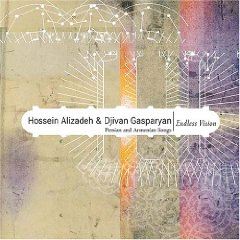
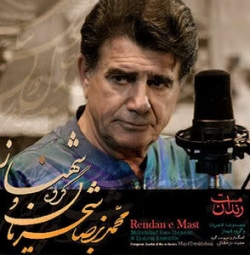
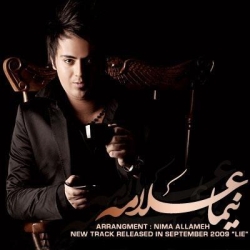
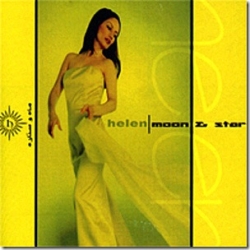


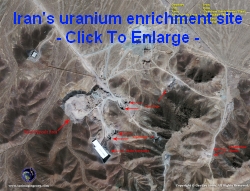
Like most countries, Iran’s music represents
the progress of Persian society over the millenia the country has
existed. It is composed of elements that reflect not only the
history of Persia, but also its people’s moral views and beliefs, as
well as those of the people’s politics, social events and the
geography of the country.
One thing that strikes most listeners about
the music of Persia is the subtlety of the sounds. To westerners it
seems to reflect deep thought, a certain warmth, and a pervasive
romanticism. To Iranian’s however, their music also reflects what
they would tell you is a closeness on their part to a celestial
world
As Persian music is classified today, the
government has labeled it as falling into one of the following three
categories:
1 - Pre-Islamic music (the music of ancient
Iranian tribes such as, Bakhtyari, Kordi, Lori, etc.)
2 - Post-Islamic music, including what is often
referred to as:
a) Maghaml or mystic music. This music includes
epic music, tyric music for marriages, birthdays and other happy
occasions, and elegiac music for mournful occasions.
b) Radif music. This form of music includes the
Dastgahs or modes of Traditional music.
3 - Contemporary Iranian music, which the
government adds as a third
“official” category. More generally, young people refer to it as Iranian National Music. This branch
covers the traditional melodies of the two above groups, but with a
classic rendition.
Strangely, the government seems to have ignored
the fact that Iranian Pop music also exists, even though it is far
more popular among young people of Iran than any of the above three
categories. Listen, for example, to the song Ba Man Mimooni
at left, and see if it doesn't remind you of American Pop from the
Disco or Club era.
- - - -
As you can see, in our music player we have selected a
fair mix of Traditional Iranian/Persian Music, as well as a broad
mix of Pop music, as it is listened today by Iranians both within
and outside of Iran. We think that if you take the time to listen to
the songs in the order we present them, you will find that you gain a good understanding
of who the Iranian people are… especially the young people. However,
we should caution you that in our music mix we have taken, and are
presenting, what classifies as Traditional Persian music out of
context. That is, rather than following the traditional format in
which this music is normally required to be listened to we are
presenting it on the basis of, well, quite simply, songs that we
thought you would prefer to hear.
For example, Iran’s
traditional singing and music is usually divided Into 12 groups.
Seven of these are broad in scope and independent in terms of
tenor. They represent what is called the Dastgah (mode). The other 5 groups
are
called Awaz, and comprise a group composed of melodies with the same gamut. Generally, in
order to play a Dastgah or Awaz a special sequence must be followed in
terms of how the musical score is developed and introduced to the
listener. Usually the order is: i) prelude, ii) Awaz,
iii) Tasnif (song) and
iv) Reng (dance tune). The late Oarvish Kban innovated and added
Plshdaramad, which is a piece that comes before the prelude,
as well as the Chahar Mezrab. In the list we have put together here, we have ignored
this entire approach—again,
opting instead to simply choose music that we thought would sound
good to you.
 One of the other things
you will notice about Iranian music is that the instruments sound
different than those used in the west, or even other parts of the
middle east. As many know, Iranian people do not think of themselves
as Arabs. In fact if you make the mistake of calling them Arabs
they will readily and even angrily remind you that they are not
Arabs, they are Persians. As to why this is the case, if one
reflects on history one will readily see that in the pre-Islam days
of Iran’s development it had much in common with not only the Arabs
that surround it, as well as Afghans and its oriental neighbors to
the East. Over time however, as Iranian’s
began to develop their own culture,
one of the things they did was develop a set of musical instruments
that, unbeknownst to anyone at the time, caused the music composed
and listened to in Iran to begin to differ from that of the
Arab countries around Iran. In part then, the root of Iran’s
"Persian-ness" comes from the musical instruments they developed, as
these fostered a cultural and audible change that forever marked
Iranian people as being different from the other cultures living in that
region. Iran’s unique musical instruments have been of immense
importance in helping the Persians define their culture as different
from that of the Arabs, since ancient times. One of the other things
you will notice about Iranian music is that the instruments sound
different than those used in the west, or even other parts of the
middle east. As many know, Iranian people do not think of themselves
as Arabs. In fact if you make the mistake of calling them Arabs
they will readily and even angrily remind you that they are not
Arabs, they are Persians. As to why this is the case, if one
reflects on history one will readily see that in the pre-Islam days
of Iran’s development it had much in common with not only the Arabs
that surround it, as well as Afghans and its oriental neighbors to
the East. Over time however, as Iranian’s
began to develop their own culture,
one of the things they did was develop a set of musical instruments
that, unbeknownst to anyone at the time, caused the music composed
and listened to in Iran to begin to differ from that of the
Arab countries around Iran. In part then, the root of Iran’s
"Persian-ness" comes from the musical instruments they developed, as
these fostered a cultural and audible change that forever marked
Iranian people as being different from the other cultures living in that
region. Iran’s unique musical instruments have been of immense
importance in helping the Persians define their culture as different
from that of the Arabs, since ancient times.
One of the more unique of
these is a wind instrument called the
ney.
It is the oldest of Iran’s unique wind instruments, and most easy to
recognize. A tube made of cane with seven joints and six knots, the
ney is what is called a “rural”
instrument, being common to all provinces and villages in Iran.
Other Iranian wind instruments include the
sorna (also,
zoornah; similar
to an oboe), as well as the
bakhtyari and
azarbaijani.
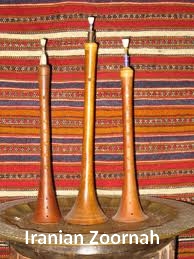 The
soma
is usually accompanied by the
dohol
or the
naghareh.
The
naghareh is
a drum-like instrument. Most commonly this three-some of instruments
are played at mourning ceremonies. Individually, or in twos, they
usually can be heard in support of street performers, like the
famous Iranian ropewalkers, or in support of marriage ceremonies
where they are used along with "wood dancing." The
soma
is usually accompanied by the
dohol
or the
naghareh.
The
naghareh is
a drum-like instrument. Most commonly this three-some of instruments
are played at mourning ceremonies. Individually, or in twos, they
usually can be heard in support of street performers, like the
famous Iranian ropewalkers, or in support of marriage ceremonies
where they are used along with "wood dancing."
Scottish people may be
surprised to find that Iranians have played a bagpipe for as long as
Scotland has, and likely even longer. Mostly used in the south
of
Iran, it may actually have migrated from Persia to Scotland along
with the great westward migration of the early middle ages. Most
Iranians refer to the bagpipe as the
khiknai.
String instruments
include the kamancheh, an
Iranian violin-like instrument that rests on the ground when being
played. The
kamancheh
is also common among Turkmen and Turk tribes.
The
barbat
is a harp-like instrument. Westerners often refer to it as an AI-e-Oud or Lout.
Its body is like a pear divided lengthwise into two parts, with a
big body and a short neck.
Among the unique Iranian percussion instruments are the
dohol,
the dayereh, and
the
tonbak.
Unusually, Iran also has
a string percussion instrument called the
santir
(similar to a dulcimer, but of much older origin).
It consists of a trapezoidal wooden box over which 72 white (high) and
yellow (bass) strings are stretched.
Enjoy the music we have for you at left. And thank you for visiting our
website.
|

